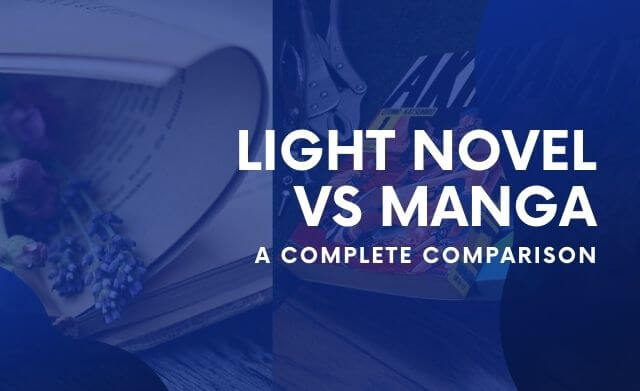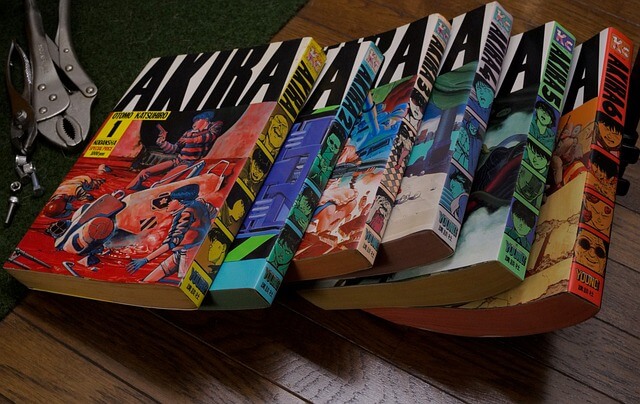
Light novel and manga are two popular genres in Japanese media. These two forms of entertainment simultaneously attract a vast audience, and the number is increasing every year. Understanding the difference between light novel and manga isn’t a challenging task for already-fans. But for those just beginning, this write-up can be a guide for them.
People often confuse these two formats because of their similar illustrations and the familiar story plots they share. Images seen in light novels are pretty much Manga-centric, and many manga plots are adapted from light novels.
The primary difference between the light novel and manga is in the style of storytelling. A light novel is a text-based form with few illustrations, while a Manga is a comic book or a graphic novel with very few texts.
Table of Contents
Comparison chart
| Light Novel | Manga | |
| Definition | A storytelling medium through text and a few artworks | A storytelling medium through artworks and a few texts |
| Reading style | Usually, Left to right. | Right to left |
| Narrative style | More detailed | Less detailed |
| Imagination | More room for imagination | Less room for imagination |
| Standard format | Bunko-bon | Tanko-bon |
What is a light novel?
It is quite confusing to define a Light novel from a theoretical sense. It primarily can be compared to a western novella or a short length novel containing a few manga-like illustrations. The story plots are fictional and usually have around 50,000 words. They are easy to read, as a result, very appealing to teenagers and young adults.

Typically, a light novel cover contains a colored illustration and a few black and white across the book to address strong characters and the plot. Maintaining a media-mix culture for the sake of business might be a factor too.
What is Manga?
Manga can be referred to as a Japanese form of a comic book. It is a storytelling medium through images and a few dialogue-based texts that appear inside speech bubbles.

Most western comic series contains many superheroes’ kind of stuff (e.g. saving humanity from destruction). In comparison, the Manga tries to follow storylines that express cultural values and many other social perspectives. There are five basic types of Manga (Shonen, Soho, Seinen, Josei, Kodumomuke), and each class targets different age groups. It focuses on multiple subjects like action, fantasy, comedy, horror, romance, and sci-fi. As for the variations, many western comic readers are getting attracted to this format more and more.
The key differences between light novel and manga
- A light novel is a Japanese form of the short novel or novella containing a few illustrations to show the central characters and story plot. In contrast, the manga is a Japanese comic that depicts its story plots through images and a few texts in speech balloons.
- The light novels that target global audiences are read from left to right, no different from Western storybooks or novellas. Conversely, unlike any other western comic book, Manga is read from right to left, and reading starts from the top right-hand corner, ends in the bottom left-hand corner.
- Their narration style is different. The light novel is almost wholly text dependant medium. Hence, they can describe things in more detail than Manga. Reading a manga is like witnessing an ongoing conversation between different characters.
- The light novel offers more room for its readers to imagine the plots and events. While manga directly shows a story plot via specific drawings that attract its readers more.
- Light novels are generally published in volumes at 6-9 months interval. Manga is published in weekly and monthly magazines on a chapter-by-chapter basis before it gets published as volumes.
A few words on the history:
The first light novel was published in the 1970s to draw several manga fans’ attention. It took more than two decades to attract a pleasant number of audiences. Light novels are generally short novels targeting young-adult readers. The texts used in it are comparatively easy. So, the term light is used in the sense of easy-reading; it has nothing to do with the length of the book.
In contrast, Manga’s origin lies in the history of Japanese art and culture. The term was first given by a famous 18th-century Japanese artist named Hokusai. A couple of decades later, the word was used in a modern sense by another Japanese artist named Rakuten Kitazawa. However, Manga gained massive popularity after world war 2 ended.
How to read Light novel and Manga?
Japanese written system usually follows the traditional Tategaki style, where the texts are in vertical lines and read from right to left. But in general, light novels are wasei-eigo: a Japanese written expression based on English words. So, most light novels have their English language version that pursues an international written pattern, no different from any English novels that read from left to right. Not to mention, enough light novels are being produced in the Japanese language for local audiences that follow the Japanese traditional written style.
Unlike other books or western comics, the Manga is read from right to left. Although the Manhwa usually follows the reading style of the west. The traditional process of reading a manga page starts from the top right-hand corner and ends in the bottom left-hand corner. The reader has to connect between the texts that appear within the speech bubbles and the images used on pages to understand the entire storyline.
Narration: a significant difference lies here
One of the most significant differences between the Light novel and manga lies in the style of narration. A large portion of the light novel is text-based. Resultantly detailed and slower in pace, has much room to bring the past or inner world elements. The light novel has an ability and scope to elaborate plots depending on the context and the writer’s intention.
Conversely, manga contains many artworks and very few texts; reading the Manga is like seeing an ongoing conversation between two or more characters. However, sometimes certain flashbacks and thoughts are seen, yet the chances are way less than light novels. So, Manga is relatively confined compared to the light novel when it comes to plot elaboration.
Words vs. Pictures: scope for imagination
Words are the root of our communication. A light novel is considered a subculture of Japanese literature, which is heavily dependent on texts. Texts can describe things in detail. Also, the reader gets more freedom to visualize things in his/her way. Each word conveys an image. Accordingly, a light novel accumulates a vast number of images that might not be seen on a page but exist in the reader’s mind (even though a light novel contains some drawn illustrations).
People generally respond way better to visuals than texts. We have habits of consuming images faster than words. When it comes to Manga, this form emphasizes illustrations, and only a few dialogues are used in text form to create a dynamic interaction. They are fluid to read and easy to grasp.
Even as Manga has mega-strength to draw attention, there is still no chance to undermine light novels.
How do the Light novel and Manga get published?
Light novel and manga hold a big part of the Japanese entertainment world. They have a billion-dollar market across the globe. According to recent data, South Korea now has a bigger market than the mother country itself. Countries like the Philippines, Vietnam, France, Mexico, Peru, Brazil are on top of popularity in reading light novels and manga.
Light novels are commonly published in volumes at 6 to 9 months intervals. Still, many serialized monthly magazines publish them in chapters. After 6-7 parts are individually released, then they are collected for publishing as a book. Usually, Light Novels are printed in bunko-bon size(A6).
Manga solely covers more than 40% of the entire books and magazine productions within Japan. Initially, published in weekly and monthly magazines on a chapter-by-chapter basis. There are a bunch of magazines in japan that release Manga regularly. Shonen Jump, Big comic, CoroCoro comic are noteworthy. Once a series gets popular enough, then its chapters are collected and published into volumes. Manga comes in various sizes and formats. But the standard professional paper size maintained is B4. They are typically printed in black and white.
Apart from printing format, Light novel and Manga have also created a vast web space in recent years. Many apps and websites that publish Light novels and manga are growing in popularity at a booming pace, and many of them are free for their readers. So, fans already have a lot of options. It only needs to make a decision to taste the exciting adventure.
Frequently asked questions (FAQs)
Which is better light novel or manga?
Both of the mediums have many unique readers. Some readers find Light novels better because this form is much descriptive as it is mostly text-based. Have way more room to bring thoughts and inner experience than a manga. On the other hand, Manga has many avid readers familiar with various artworks showing facial expressions and body postures. Manga might be a better form for them than light novels.
What do light novels look like?
Light novels are short novels containing a few artworks. It has around 50,000 words. Typically includes a colorful illustration on the cover, and other illustrations used generally are black and white.
Is there a manga for Overlord?
Overlord started its journey in a light novel form. However, it has an ongoing manga adaptation series since 2014. Satoshi Oshio writes overlord manga, and Hugin Miyama draws the illustrations for the series.
Do light novels have pictures?
Light novel is heavily text-based, with a few pictures depicting the main characters and the story plot.
Where to read light novels?
light novels are available in book stores around the world. However, readers get the opportunity to read them on websites and apps as well. There are free and paid options available to readers. A few popular websites to read light novels are kisslightnovels, readlightnovels, lightnovelworld, bookwalker, and many more.
Conclusion:
The root difference between light novel and manga lies in the way of storytelling. Texts grab the attention of the readers differently from illustrations. Whether you prefer texts or images, there are enough resources nowadays to quench your thirst. What would you choose, a visual storytelling format full of conversations or a procession of words that explores the inner world?

Carroll is a day-time writer and a night-time reader. A blogger and a content strategist. She has been writing for online platforms since 2010. An avid reader and a movie lover.
